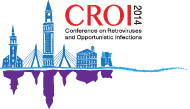Efavirenz maintenance therapy effective in children exposed to nevirapine prophylaxis
24 March 2014. Related: Conference reports, Paediatric care, CROI 21 (Retrovirus) 2014.
Polly Clayden, HIV i-Base
 Children exposed to nevirapine prophylaxis who are initially suppressed on lopinavir/ritonavir-based therapy can safely switch to efavirenz-based maintenance therapy, according to data presented at CROI 2014.
Children exposed to nevirapine prophylaxis who are initially suppressed on lopinavir/ritonavir-based therapy can safely switch to efavirenz-based maintenance therapy, according to data presented at CROI 2014.
Lopinavir/ritonavir is recommended as first-line therapy for infants and young children in resource-limited settings. This is partly to overcome NNRTI resistance following nevirapine prophylaxis, which is still widely used in PMTCT programmes globally. However, treatment with lopinavir/ritonavir has a number of shortcomings including: cost, palatability, managing concomitant TB treatment and potential metabolic complications.
The NEVEREST 3 trial was designed to find out whether switching nevirapine-exposed children who start on lopinavir/ritonavir-based ART (and are stable) to efavirenz-based maintenance therapy is equivalent virologically to staying on lopinavir/ritonavir.
Ashraf Coovadia from Rahima Moosa Mother and Child Hospital in Johannesburg, presented data from NEVEREST 3 on behalf of colleagues from University of the Witwatersrand, Johannesburg; Columbia University, New York; and Institute of Communicable Diseases, Johannesburg.
This was a 48-week, non-inferiority, open label, randomised trial, enrolling 300 children; two were lost before starting the trial and 294 completed follow up.
Children who had been exposed to nevirapine prophylaxis, initiated lopinavir-based therapy <24 months of age and suppressed <50 copies/mL at enrollment. They were randomised to switch to efavirenz or stay on lopinavir/ritonavir. Children had regular viral load, CD4 and other laboratory tests, growth measurements and clinical assessments throughout 48 weeks follow up.
Primary endpoints were: viral load >50 copies/mL at any time during follow up; and confirmed viral failure >1000 copies/mL. The non-inferiority margin was 10% ie the study was powered to exclude this difference between arms in virologic efficacy.
At baseline, children were an average of 4.1 years of age, just over half were girls, they had initiated ART at about 9 months and had been on treatment for about 3.5 years. About 60% received abacavir, 35% d4T, and the remainder AZT; all children received 3TC.
Both primary endpoints were non-inferior in the efavirenz arm vs lopinavir-ritonavir. A higher proportion of children in the lopinavir/ritonavir than the efavirenz arm had viral rebound >50 copies/mL: 28% vs 17%, difference +11% (95% CI 1.6 to 20.5), p=0.03. Similar proportions had viral failure >1000 copies/mL: 2% vs 2.6%, difference 0.6% (95% CI -4.1 to 2.8) p=0.68. Professor Coovadia noted that this rate of viral failure was exceptionally low.
At 48-weeks there was a greater increase in CD4 percentage in the efavirenz arm vs lopinavir/ritonavir: to 37% vs 34%, p<0.001. Professor Coovadia remarked that this might mean very little clinically.
There were no deaths in either arm, hospital admissions were rare but two children had efavirenz related seizures that stopped after discontinuing the drug. There was a spike in reported sleep difficulties and nightmares in the efavirenz arm, with 28% of children reporting this at 4 weeks, but there was no difference between the arms at 8 weeks. There were no differences by arm in behavioral problems assessed by the Strengths & Difficulties Questionnaire (SDQ). Weight- and height-for-age were in the normal range and similar across arms. Laboratory abnormalities and other complications were rare.
In conclusion, the investigators wrote: “We advise consideration of such a switch strategy in treatment programmes particularly in resource constrained settings.”
comment
These results are welcome, not least as Professor Coovadia pointed out where “practice is preceding what the science shows” – programmes are already switching children from lopinavir/ritonavir to efavirenz in this situation.
WHO and national guidelines are clear in recommending that young infants and children start on lopinavir/ritonavir-based treatment. They are also clear that older treatment naïve children should start on efavirenz. What is less clear is whether children initiated on lopinavir/ritonavir should switch to the preferred regimen for older children once they become older. Professor Coovadia suggested that there would need to be a lot of discussion about what these results mean for guidelines and programmes.
Hopefully, with more widespread uptake of maternal ART in pregnancy, nevirapine prophylaxis exposure for children will soon be a thing of the past, and treatment recommendations will not need to take this into consideration.
Authors note – about halfway through the presentation Professor Coovadia gives one of the best explanations of non-inferiority I have heard and deserves a plain English award! It is worth checking out the webcast for that too.
Reference
Coovadia A et al. Virologic efficacy of efavirenz maintenance therapy in nevirapine prophylaxis-exposed children. 21st CROI, 3-6 March 2014, Boston. Oral abstract 73.
http://www.croiwebcasts.org/console/player/22147

